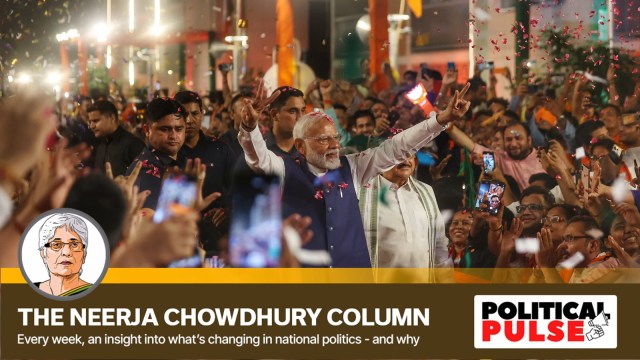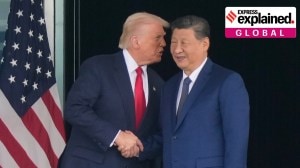Refrain behind verdict: ‘Centre’s power too one-sided, a little ankush (restraint)?’
The BJP leadership will now have to rule at the head of a coalition government, take along its allies, and be more mindful of its own party leaders who were given short shrift.
 In democratic politics, arithmetic also shapes chemistry and Prime Minister Narendra Modi knows that. (Express Photo by Tashi Tobgyal)
In democratic politics, arithmetic also shapes chemistry and Prime Minister Narendra Modi knows that. (Express Photo by Tashi Tobgyal)If one word can sum up the outcome of the 2024 elections, it is the Hindi word, ”ankush,” (restraint) that the Indian voter has exercised — she has given the BJP the mandate to rule for a third term — but has also reined it in.
The BJP leadership will now have to rule at the head of a coalition government, take along its allies, be more mindful of its own party leaders who were given short shrift. The BJP may still dismiss concerns raised by the Opposition but it will be aware that it can’t quite get away with it – with a 60-plus dip in their tally.
In democratic politics, arithmetic also shapes chemistry and Prime Minister Narendra Modi knows that. Ever since he began contesting elections in 2001, he has never been part of a formation that’s not in majority — until now. This did have an echo on the campaign street.
After the BJP’s sweeping victories, the break-up of Opposition parties, the arrest of two sitting Chief Ministers, the use of Central agencies, the stand-off between Governors and CMs, the way Rahul Gandhi was disqualified, many people, including BJP voters, would ask, “Kuchh zyada toh nahin ho raha? Thoda ankush hota to achcha hota.” (Isn’t this too much, too one-sided…a little restraint would be good).
This refrain cut across sections.
Reacting to the unbridled power the “400 paar” slogan signalled, the banker in Mumbai worried whether it would lead to “a one-party rule” or a “change in the preamble and basic structure of the Constitution”. A top corporate called for a little more elbow room in the echelons of power. Dalits, especially the politically empowered influencers in their communities, sitting in their tolas in UP, Rajasthan or Maharashtra, discussed how an “ek-tarfa success” for the BJP may entail a change that would finish “Baba’s kitab” (BR Ambedkar-shaped Constitution) and end reservations given to them; Rajputs in UP worried their community kinsman, Chief Minister Yogi Adityanath, might be shunted out after the Lok Sabha elections, if the party leadership gained strength. Many of them, for instance, stayed away on voting day.
In one way or another, all wanted checks and balances to kick into a situation which they saw moving towards “uncontrolled success.”
But then “ankush” is not so easy to calibrate.
More so, when there were reports that in some key segments, the RSS, smarting because of being sidelined by a powerful BJP, did not come out to campaign as enthusiastically as it had done in earlier elections.
The words of the BJP President JP Nadda in the midst of the poll campaign — that the party had now grown independent of the RSS and did not need any hand-holding— illustrated the re-ordering of the relationship between the Modi-led BJP and the RSS. The pushback in many places also came from within the system — the party and the (Sangh) parivar.
While the results did not come as a surprise in some states, it is Uttar Pradesh which has caught many, including political parties, off guard. Even the senior leadership of the Samajwadi Party had not expected such a victory. Akhilesh Yadav’s experiment of widening the party’s MY (Muslim -Yadav) base by giving tickets to non-Yadav OBCs and Dalits seems to have paid off. Many Dalits from Mayawati’s BSP, which is on a secular decline, appear to have shifted to the SP.
The 2024 election was not a Hindu-Muslim battle, as in 2014 and 2019—which normally holds the BJP in good stead.
Travelling across Uttar Pradesh for the first two phases, this reporter found not a single person, including the candidates themselves, saying that this was a Hindu-Muslim poll. Over the weeks that followed, the Prime Minister’s pitch to invoke mangalsutra, mujra, or the Muslim league manifesto of the Congress, arguing that reservations from the OBCs, STs, SCs would go to the Muslims, didn’t strike the chords he would have expected.
In many places, even as 10 years of the BJP has reinforced a distinct Hinduisation of the Hindus, this reporter also heard a refrain of another reality. Many people, including those who vote for the BJP, say, “Bahut ho Gaya Hindu-Muslim…after all, we have to live at peace with each other.” While they are conscious of their Hindu identity, could it be that they no longer wanted a perennial Hindu-Muslim conflict to be used to distract or deflect.
In Bihar, while Tejashwi Yadav tried to widen the RJD’s Muslim-Yadav base by reaching out to the non-Yadav OBCs—he gave seven tickets to Kushwaha candidates — it is Nitish Kumar, though maligned for his frequent flip-flops, who managed to keep the RJD in check.
Though weakened, his continuing hold on his old constituency of non-Yadav OBCs, Mahadalits, Pasmanda Muslims, and women along with the BJP’s vote base, contained the RJD, as he won 14 out of the 16 seats he contested. Tejashwi could not do what Akhilesh Yadav managed. Had Nitish Kumar remained on the INDIA side, the Bihar—and the INDIA—story might have been different.
In Maharashtra, the other success story for the INDIA alliance, the BJP move to break the Shiv Sena and the NCP generated a sympathy for Uddhav Thackeray ad Sharad Pawar giving the Maha Vikas Aghadi 30 out of 48 seats. The MVA was able to forge a Maratha-Muslim-Mahar (Dalit) axis –which at one time formed the base of the Congress—with Muslims voting in large numbers for the Shiv Sena known for its Hindu credentials.
Verdict 2024 has pumped oxygen into India’s democratic system; a strong vibrant opposition is a sine qua non of democracy and, clearly, the people of India have felt the need for it—and voted for it .
The Opposition parties fought well—though they still have a long way to go. A Congress on the revival path, almost hitting the 100 mark, endorses the leadership of Rahul Gandhi.
It will also send its own message to the country’s institutions. The party stands a good chance in the state elections that are due in the next year—Maharashtra, Haryana, Jharkhand, Delhi. Much will depend on the savvy the Congress shows in how it tackles the June 4 aftermath with its INDIA allies.
The BJP has held its own in Madhya Pradesh, Chhattisgarh, Uttarakhand, Himachal Pradesh, Delhi, it has wrested Orissa from Naveen Patnaik’s BJD. It has piggy-backed Chandrababu Naidu to power in Andhra Pradesh, formed a government in Arunachal Pradesh, and improved its tally in Telengana. It did not do as well as expected in West Bengal, where Mamata Banerjee fought back, and in Karnataka, it has lost seats in Rajasthan and Haryana, where there was palpable anger amongst Jats. But the BJP is set for a third term in office. A section in the party underlines that its tally, even if diminished, is after being in power for ten years and that would not have been possible without Modi.
What now for the third Modi government, as India moves back towards a two-coalition bipolarity? The BJP will introspect, go back to the drawing board. It has a solid record of learning and course-correcting. Will Modi and his system show the flexibility the new situation demands? How will he deal with allies who can pull him down, and who may not be on the same ideological page? In his third term, Modi may have quite a few firsts to pull off.





- 01
- 02
- 03
- 04
- 05


























